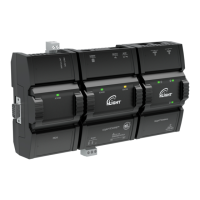About the 2.4 GHz ISM Band
The 2.4 GHz ISM (Industrial, Scientific and Medical) band has been allocated worldwide for the use of radio frequency en-
ergy by industrial, scientific, and medical purposes as part of the device’s method of internal operation and as such may
have powerful emissions that cause interference to radio communications.
For example, microwave ovens operate in the 2.4 GHz ISM band with about 1000W emitted power and a fraction of a per-
cent of that energy does leak from the oven. While this is not a health risk, Wi-Fi networks operate at even lower power
levels to communicate and can be overwhelmed by this source of interference.
When setting up a 2.4 GHz band Wi-Fi network, you must take into consideration any equipment that operates in the 2.4
GHz ISM band such as medical and laboratory equipment. Other sources of interference are other telecommunications
equipment such as cell phones, GSM/DECT, cordless phones, RFID reader, Bluetooth devices, walkie-talkies, baby moni-
tors, and so on. Note that equipment that transmits in other frequency bands do emit spurious emissions at low levels over
a wide spectrum so that a radio transmitter that is in close proximity to the ECLYPSE Wi-Fi adapter can cause interfer-
ence, even if its operating frequency is 1.9 GHz for example.
Frequency
Power (Log)
Transmitted
power
Center
Frequency
Occupied
Bandwidth
Spurious
Emission
Amplitude
Desired Signal Spurious Emissions
Figure9: Typical Radio Transmitter Spurious Emissions
Distance Between the Wi-Fi Adapter and Sources of Interference
Unrelated transmitters should be more than 6.5 feet (2 m) away from the Wi-Fi Adapter to avoid possible interference.
About Wi-Fi Network Channel Numbers
Wi-Fi communications use a slice of radio spectrum or channel width for data transmission. In general terms, the amount
of channel width required is proportional to the data transmission rate. Wi-Fi networks operate in a number of different fre-
quency ranges or bands such as the 2.4 GHz band. Each band is divided into a number of industry-standard channels that
represent a center frequency for data transmission. In practice, the center frequency is the mid-point between the upper
and lower cutoff frequencies of the channel width.
When the channel width is larger than the channel spacing (the space between channels), overlap between the channels
can occur, resulting in inter-channel interference that lowers overall network throughput. This is shown in the diagram be-
low. For example, in the 2.4 GHz band using 802.11g, the channel width is 20 MHz while the channel spacing is 5 MHz. If
one Wi-Fi network is using channel 1 that is in close proximity to another Wi-Fi network that is using channel 2, there will
be significant inter-channel overlap and interference. Data throughput is reduced as a result.
Connecting IP Devices to an IP Network
23
nLight ECLYPSE

